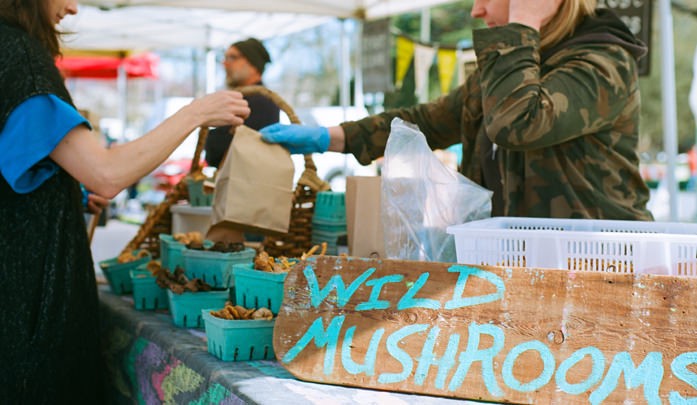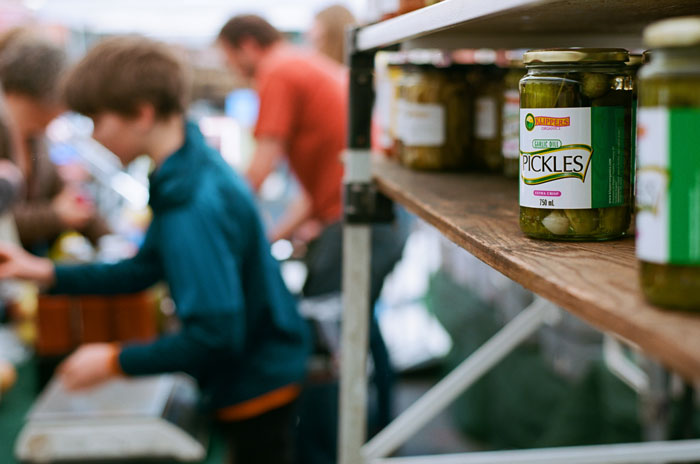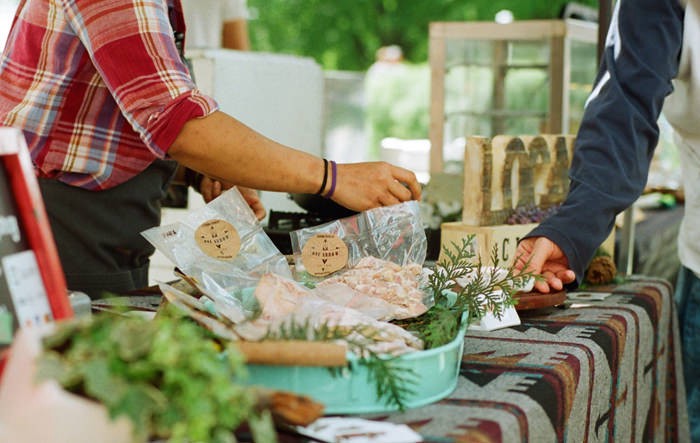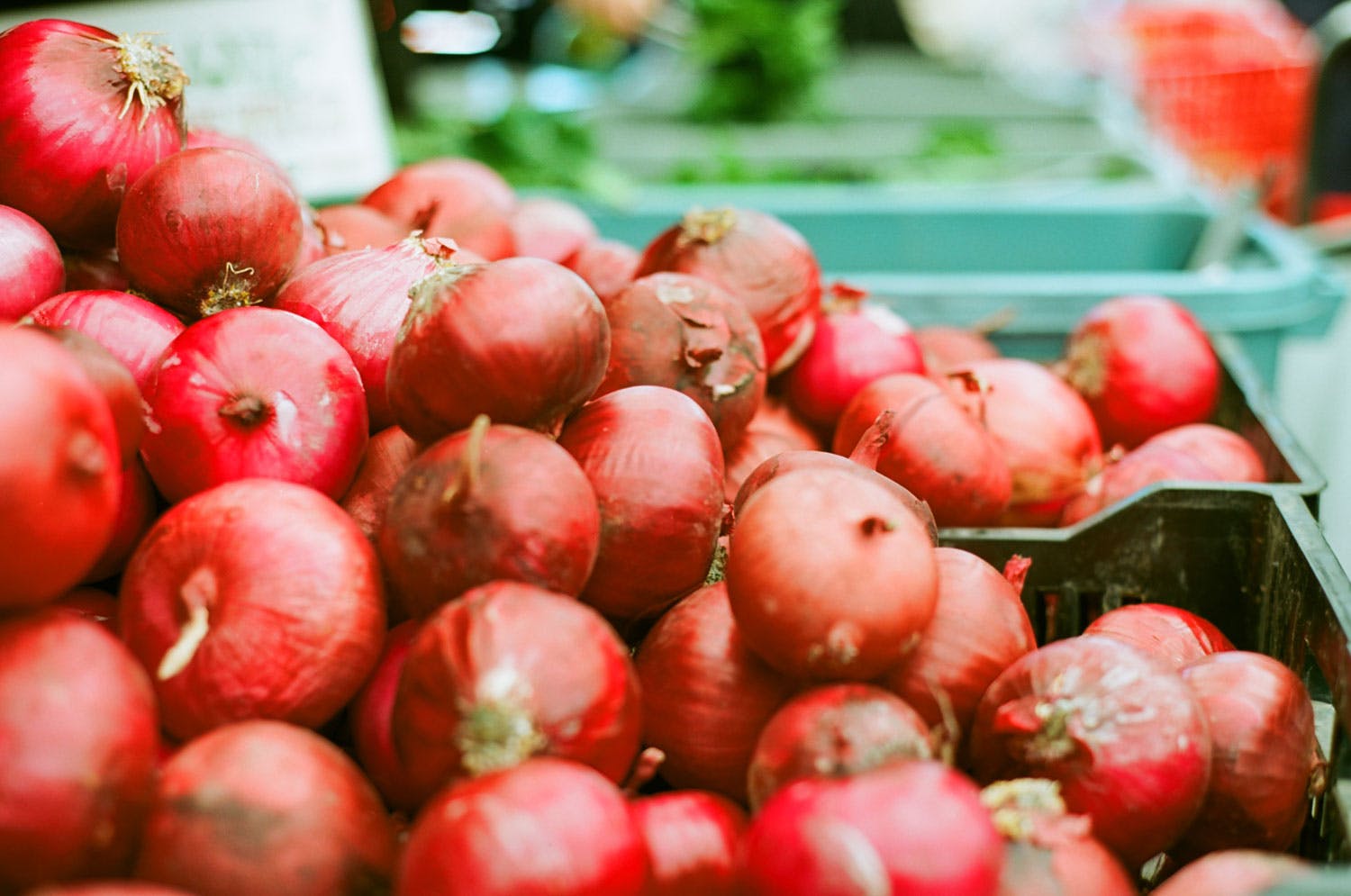Asparagus Magazine’s Guide to the Farmers Market
Freshly picked answers and questions to celebrate local bounty from the ground up.
Technology changes down on the farm may not rival those in our phones or cars, but modern agri-food systems are constantly innovating to improve what we eat and how it reaches our plates. And while the farmers market may be rooted in the timeless tradition of neighbours feeding neighbours, it too has evolved.
In addition to the expected seasonal produce, markets now often offer many foods with a face — whether bovine, ovine, fish, or fowl — and an ever-increasing number of small-batch products, from home-style to leading-edge. (Artisanal kombucha, anyone?) All told, a successful trip to the farmers market now demands many more informed choices.
Asparagus is all about rooting daily decisions in expert knowledge, so we’ve assembled this guide in time for summer market season. In it you’ll find:
- the principal definitions, certifications, and other terminologies in use at most markets; and
- the seeds of good questions you can ask to help find producers and products with values that mirror your own: animal welfare, heritage foods, reducing your environmental footprint, or all of the above.
Market ABCs (Anything But Commodities)

What defines a farmers market?
In essence, it’s a marketplace where buyers can speak directly to a grower and purchase their freshly harvested produce. And — per the Washington State Farmers Market Association — it’s also the small-scale farmer’s best opportunity to profit from and sustain their acreage.
In Asparagus’ home province of British Columbia, the type of farmers market recognized by municipal governments (with supportive permits) and regional market associations is exclusive to vendors who “grow, make, bake, raise or wild harvest” the products they sell, all of which must also be grown and/or processed in the province.
What truly distinguishes a farmers market is its across-the-board commitment to quality of life.
A true farmers market prioritizes local farmers and food vendors, though it may not be as strict as those in BC. This definition holds most everywhere, though Washington State markets do allow resellers who sell other farmers’ or processors’ products, they just must represent themselves as doing so.
What truly distinguishes a farmers market is its across-the-board commitment to quality of life: for its customers, certainly, and for the growers and producers, animals and birds, fruit on the trees, and vegetables in the ground. Fresh and tasty products aside, this commitment is at the core of markets’ value to communities’ health and sustainability.
- Though vendors welcome all inquiries, take any probing questions about market policies and practices to the onsite managers’ table first. They’re also the people to ask about seasonal events, and the always interesting “What’s new today?”
Speaking of value, why are market products often expensive?
That’s simply a true reflection of the cost of good food. Heritage seeds and diverse species, fair wages and ethical business practices, handcrafted products and personal attention all require substantial investment. Remember, too, that along with gas for their truck, the grower/producer has also paid to secure their spot, and likely hired helpers to assist with set-up/load-out and sales.
No one shopping at a farmers market is being gouged, and farmers selling at them aren’t getting rich. Sustainability, quality, and flavour are what you’re paying for.
Can I haggle for a better deal?
Please don’t. Well-managed farmers markets typically have rules against bargaining and bartering. In her self-published A Farmer’s Guide to Farmers Markets, Anna Helmer — purveyor of chefs’ favourite Pemberton Valley potatoes — highlights the value of price parity to her colleagues: “If you choose to undercut, not only will you make fewer friends but you probably make less money.”
The best opportunities for discounts and deals come at events celebrating seasonal abundance — like a peak-tomato festival — or via the many community-supported agriculture (CSA) programs offered by single or multiple vendors. (In a CSA, a pre-season investment entitles you to pick up a weekly share of what’s freshest from the fields and orchards.)
- You can ask if a vendor is open to a post-market deal on “culls” and remainders (potentially preferable to reloading them on the truck), though be prepared to buy enough to clearly do them a favour.
No one shopping at a farmers market is being gouged, and farmers selling at them aren’t getting rich.
What if I simply can’t afford those higher prices?
Another core value of farmers markets is accessibility: all members of the community are welcomed, including those living on low or fixed incomes. The majority of state and provincial market associations up and down the West Coast — often in partnership with governments and public health authorities — offer programs to help ensure fair access to farm-fresh products for those struggling economically.
BC offers “nutrition coupons” to low-income families, and Washington, Oregon, and California all have arrangements that let recipients of food benefits use those funds at markets. California also has a special market program for seniors. A visit to your market’s website or onsite manager’s table will typically provide details on these programs.
Bountiful Harvests

Is it OK to ask “When was this picked, and by whom?”
Go for it! It may seem like a loaded question, but it’s the simplest, most direct way to get to know growers and their farms. Most won’t bat an eye at the inquiry, and if they do, well, you’ve already learned something.
The answer should offer useful tidbits on the farm’s size, distance from the market, type of field labour employed (family, locals, volunteers), and indicate how much attention is paid to flavour and freshness. Follow up by asking the grower how they judge ripeness and quality. You’ll likely learn something else of real value.
- If you can’t spot your favourite fruits or vegetables, ask growers for their best guess on the timing of this year’s peak season for them.
Should I favour certified organic vendors over conventional and uncertified producers?
Usually a good idea. Driven by decades of steady growth in popularity across all food sectors, certified organic production is the rule, not the exception, at most regional markets. Both Canada and the US have well-established and regularly updated national standards*, which have been adopted by provincial and state certification authorities.
As a rule, the majority of markets only permit vendors with third-party-verified organic certification on file to describe, on signage or verbally, their products as organic. The value of certification is genuine, though not all growers want to deal with the added expense and bureaucracy involved in obtaining and sustaining an organic label.
You can ask if a vendor is open to a post-market deal, though be prepared to buy enough to do them a favour.
Some farmers prefer to apply their own time-tested expertise in growing their products organically, which then becomes a question of trust for their buyers. Given this, market managers typically do their due diligence in reviewing grower production methods (via the application process) to ensure consistency in quality.
- Ask non-certified growers whether they use organic seed and approved organic fertilizers, and why or why not? If you’re really curious, ask them why they haven’t sought, or no longer seek, certification.
*You can review the finer points of organic certification at these sites: Organic Trade Association, Choose Canada Organic, and Certified Organic Associations of BC.
Is it true that organic farmers can use toxic pesticides, as long as they come from nature?
The short answer is no. It should come as no surprise that there’s plenty of fake news feeding the “organics are just as toxic” story, much of it generated by commodity marketing groups looking to discredit and devalue organic produce. However, as growing conditions change more quickly — thanks to climate change, among other factors — the demand for innovative and safe pest-control solutions is burgeoning.
The Organic Materials Review Institute (OMRI) is a private, non-profit organization that determines (and regularly reviews) whether or not a product qualifies as organic. Both the US and Canadian organics programs recognize OMRI standards, though each applies them slightly differently.
The upshot is that you shouldn’t expect busy local farmers to be aware of every emerging concern about specific substances. If you have questions about whether they use certain products, just ask. Most growers will happily tell you about their processes.
The key thing to know is that only about 100 synthetic substances — most of those naturally derived — are approved for organic farming (to control pests and treat sick livestock); conventional agriculture uses close to 1,500, according to the US Organic Trade Association. The other important thing to realize is that certified organic growers may only use the allowed substances as a last resort, if their go-to methods like fighting pests with natural predators are ineffective.
The important thing to realize is that certified organic growers may only use synthetic substances as a last resort.
What is biodynamic growing?
Certified organic production has its detractors and boosters, as well as those who don’t think it goes far enough in ensuring truly regenerative, sustainable agriculture. After World War I, Austrian philosopher and social reformer Rudolf Steiner — who also created the Waldorf education system — developed a growing method he dubbed “biodynamic.” It advocates a holistic, ecological approach, bringing environmental, social, and economic considerations into balance.
Biodynamic farms operate in alignment with natural cycles (seasons, phases of the moon), and supplement their soil and crops with “preparations” made from herbs like chamomile and stinging nettle, and more esoteric practices like burying manure inside a hollow cow horn over the winter.
If you’re interested in products that go beyond organic, biodynamic growers are the folks to talk to. And if you pick their brains for ten minutes on a busy market day, be sure to buy some of their products on the way out.
- Ask these growers which products they think reflect the best of biodynamic production (hint: berries). Be sure to buy some samples to taste-test beside organic and conventional varieties.
How is a heritage variety different from an heirloom one?
First, a not-so-fun fact: according to the UN’s Food and Agricultural Organization, roughly only nine plant species accounted for 66 percent of total crop production in 2014. The risks inherent in this fading biodiversity not only affect future food supplies, but also limit our access to flavour and, more often than not, nutrition.
The antidote to fading biodiversity may well be growing on a local farm.
However, the antidote may well be deposited in a secluded seed bank, or growing on a local farm. Heirloom and heritage plants are essentially the same thing: open-pollinated — as opposed to artificially hybridized — seed varieties, grown and passed down through a farming family (as an heirloom) or by a company. Most often, these varieties are selected for both their unique taste and ability to thrive in local conditions. In either case, discovering the surprising range of flavours, colours and textures available from heirloom and heritage produce is one of the best perks of exploring local farmers markets.
- If you’re a gardener of edible delights, ask whether the vendor will sell you some heirloom seeds, or point you where you can secure your own.
Pedigreed Proteins

What should I ask about livestock products at the market?
Farm-fresh eggs have been a staple of local markets for decades, but in recent years the interest in healthier, tastier non-commodity meats — particularly poultry, beef and pork — has led to more stalls allotted to local small-scale producers.
There are three factors that distinguish organic (or artisan) meat and dairy production from commercial systems: lots of room to roam, access to a natural diet, and humane treatment — especially at the end of life. All three contribute to the animals’ quality of life, as well as the flavour and nutrition of the end product.
Organic standards demand that all livestock have free access to graze outdoors (supplemented with organic feed), except in the case of extreme bad weather or health issues. Some non-organic chickens are “pastured” using mobile coops, which are intended to be regularly rotated onto fresh and tasty grass. For non-organic beef or dairy cattle, a single cow per acre of grassy pasture is best. Ask growers about their methods.
- Always ask what the animals are fed. Like us, they are what they eat.
Is “pasture-raised” the same as “free-range”?
No, though the principle is the same. Hogs — particularly heritage breeds such as Berkshire and Tamworth — are often pasture-raised with a wide range of plants to snack on. Ask what the producer feeds them off-pasture.
Large flocks of non-organic, cage-free, “free-range” chickens and turkeys typically roam around barns pecking at supplied feed with little-to-no access to pasture. Not that there’s anything horribly wrong with this, but regular yard time — as required by organic standards — can add a lot to the flavour and quality of both their eggs and meat.
Regular yard time can add a lot to the flavour and quality of both eggs and meat.
Do I want “grass-fed” or “grass-finished”?
Beef cattle, sheep, and goats are natural grass-eaters; they’re healthiest and happiest when that’s all they eat, but some producers alter that diet for a variety of reasons (mostly economic).
Grass-fed animals might spend the bulk of their lives grazing, but can still be fed grain or corn to bulk up their weight before heading to market. However, this often affects the quality of the meat, with the animal losing the majority of the benefits an all-grass diet would have provided to their eventual eaters. That said, animals raised on grain who finish their lives on an all-grass diet (“grass-finished”) can receive a healthy boost in quality.
For maximum flavour and health, look for 100% grass-fed or grass-finished meats for optimum ratios of omega-6 and omega-3 fatty acids.
- Ketonians and paleophiles should ask producers about bulk/freezer orders. Be sure to confirm all timing and delivery logistics, but always anticipate some variation.
Makers and Bakers

How do prepared food vendors qualify for the market?
At the majority of markets, the people behind the table had a hand in crafting the freshly-baked loaves, pots of fruit jellies, bags of granola, and bottles of beer on display. Market managers will have screened these vendors through the selection process to ensure their small-batch production methods and facilities meet standards for quality and food safety.
The market is often a terrific place to discover products with a fresh spin on flavour or a rare and deep nod to tradition. Start any visit to a prepared food/beverage vendor with a request for their product’s origin story to get the gist of what it means to them. A taste test is also a must.
How much local content is required in prepared foods and beverages?
Managers at farmers-first markets — like those in BC — give priority access to prepared food and craft vendors that use regional sources for ingredients and materials. However, the local content can legitimately consist of an authentic cultural or family tradition in the preparation of foods, whether homegrown or not. Sharing traditional and locally popular dishes within a neighbourhood or region sustains the community’s cultural (and flavour) diversity.
- Ask if they buy ingredients from fellow vendors, and why or why not.
Each dollar spent in direct purchases from farmers adds about $3 in regional spending.
Are prepared foods sold at farmers markets always sustainable?
The short answer is yes. The folks making sweet or savoury preserves from local organic fruits and vegetables are supporting a sustainable food system, particularly if their raw ingredients are culls otherwise destined for compost. And the multiplier effect of buying local food is good for the whole economy: one 2009 study in Ontario found each dollar spent in direct purchases from farmers added about $3 in regional spending.
But even those crafting decorative items or providing a tool-sharpening service make a difference, by preserving artisanal skills that contribute to community resilience. Safe to say we’re all going to need more of that moving forward…no matter where you live and what you eat.
More tips for a better market experience
- BYOB: Bring your own (shopping/tote) bags
- Though many vendors take cards, cash is always appreciated, especially small bills. Embrace this as another unique market feature: the hand-to-hand personal transaction.
- Try flashing a smile when you ask your questions. You’ll get a better answer and likely learn even more.
Print Issue: Summer/Fall 2019
